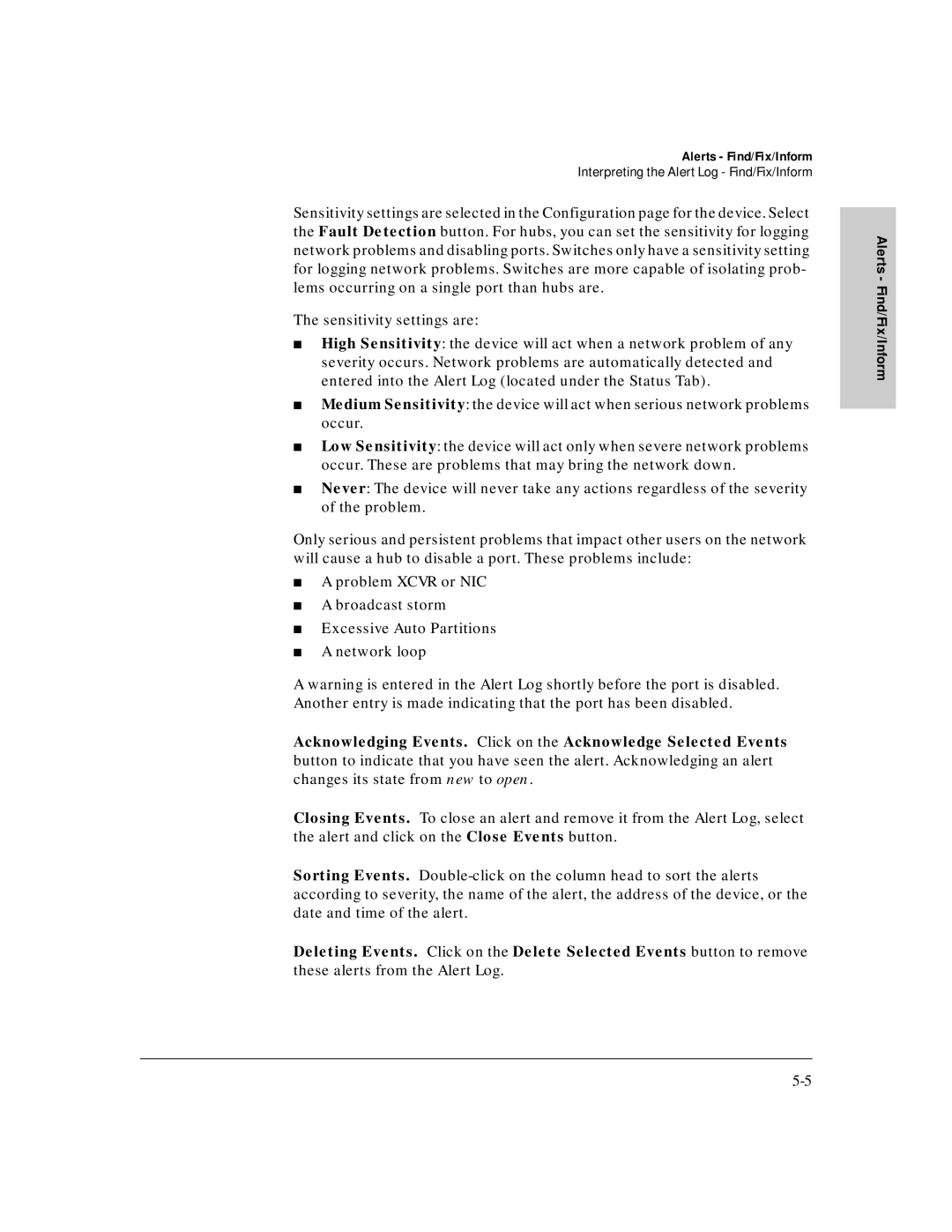User Guide
HP Hub & Switch Management for OV-UX
Publication Number
Contents
Alerts Find/Fix/Inform
Setting Up Security for a Device
HP Hub & Switch Management Admin
Introduction
Information About HP Hub & Switch Management for OV-UX
HP Proactive Networking
Features of HP Hub & Switch Management
Control
Uptime
Several new switches are supported, as described below
Support for New Switches
Technical Product Support
Technical Product Support
Support Information
Before Installing HP Hub & Switch Management for OV-UX
Hardware
Management Station Requirements
Software
Hub For OV
Required Network Configuration
Required Network Configuration
Before Installing HP Hub & Switch Management
Required Patches
Required Patches
Removing HP Hub & Switch Management
Installation Directories
Removing HP Hub & Switch Management
Management products
HP Hub & Switch Management Overview
Introduction to HP Hub & Switch Management
HP OpenView Network Management Platform
Definitions, Processes, and Files
HP OpenView Network Management Platform
Definitions, Processes, and Files
Snmp Manager and Agents
HP Devices That Can be Managed
What HP Devices Can Be Managed
What HP Devices Can Be Managed
HP J2410A AdvanceStack 100 VG Hub-15Note
HP J3204A AdvanceStack 10Base-T Switching Hub-24TNote
HP J3202A AdvanceStack 10Base-T Switching Hub-24RNote
HP J3245A AdvanceStack Switch 800T
HP J3298A HP Procurve Switch 212M
Snmp Configuration and Snmp MIB Browser
Running HP Hub & Switch Management
Starting the Manager Application
Starting HP OpenView
Display
Starting the Manager Application
Verifying Installation of the Manager Product Set
Verifying Installation of the Manager Product Set
Monitor HP Hub/Switch
Addressed HP hub, bridge, or switch
Stopping and Restarting the Manager Application
Stopping the Manager
Stopping and Restarting the Manager Application
Restarting the Manager
Use the command /opt/OV/bin/ovstart
Management
HP Proactive Networking
Alerts Find/Fix/Inform
Control
Alerts Find/Fix/Inform
Performance
Uptime
Interpreting the Alert Log Find/Fix/Inform
Interpreting the Alert Log Find/Fix/ Inform
Find/Fix/Inform Faults
Alerts Find/Fix/Inform
Log for first time installation information for the device
More Information on Device Features
Accessing Hub Features
Accessing FHub eatures
More Information on Device Features
Accessing Hub Features
Accessing the Device View
Accessing the Device View
Viewing Device Identity Information
Interpreting Device Status
Reading the Performance Gauges
Switching Hub Global Counters
Switching Hub Global Counters
Status Global Counters
Hub Global Counters
Status Port Counters
Configuring Your Device
Base-T Hub-12M Device View
Configuration Fault Detection
Fault Detection Sensitivity Settings
Configuration System Information
Configuring IP
Hub IP Configuration
Switching Hub IP Configuration
Configuration Backup Links
Port Configuration
Hub Port Configuration
Or no violation
Backup Link Parameters
Configuration Support URL
Configuring Load Balancing Switching Hubs
Before the backup port becomes active
Retries
Accessing Hub Features
Switch Status
Managing Switches
Managing Switches
Switch Status
Graph Area
Switch Status Overview
Description
Alert Log Area Find/Fix/Inform
Status Port Status
Port Status Settings
Identity
Configuration
Device View
Identity
Configuration
HP ProCurve Switch 8000M Device View
Switch IP Configuration
Configuration IP Configuration
Configuration Port Configuration
Click on Modify Selected Ports to change the mode
With the device on that port to determine the mode
Following
Trkx The port trunk to which this port belongs
Flow Control
Configuration Assigning a Monitoring Port
Drops any flow control packets it receives
10/100TX, 10FL, 100FX
Selecting a Monitoring Port on a Switch
Using Vlans
Automatic Broadcast Control ABC
Configuration Device Features
Automatic IP Gateway Configuration
Enabling Broadcast Control for IP
Enabling Broadcast Control for IPX
Internet Group Management Protocol Igmp
Forward with High Priority
Spanning Tree Protocol
Support URL
Configuration Support/Mgmt URLs
Management Server URL
Managing Switches
Device Passwords
Setting Up Security for a Device
Setting Up Security for a Device
Device Passwords
Up Security for a Device
Manager/Operator Password Combinations
Manager/Operator Password Combinations
Setting Up Security Device
Function of Community Names
Address Selection
Port Security hubs only
Address Selection
Port Security hubs only
Send Alarm
Authorized Address
Eavesdrop Prevention
Set Trap Receiver Thresholds
Disable Port
Set Security Policy for Selected Ports hubs only
Intrusion Log hubs only
Set Security Policy for Selected Ports hubs only
Intrusion Log hubs only
Performing Diagnostics
Performing Diagnostics
Performing a Ping/Link Test
Performing a Ping/Link Test
Rebooting a Device
Rebooting a Device
Resetting a Hub to Factory Default Settings
Producing a Configuration Report
Resetting a Hub to Factory Default Settings
Producing a Configuration Report
HP Hub & Switch Management Admin
Starting HP Hub & Switch Management Admin
HP Admin Parameters
HP OpenView Device Symbols
HP Hub & Switch
Network Parameters
User Interface Parameters
User Interface Parameters
Graph Option Parameters
Graph Options Parameters
Management Admin HP Hub & Switch
Printer Configuration Parameters
Set As Default
OpenView Configuration Options
Installed Printers list
Printer
OpenView Configuration Options
Opt/netscape/netscape
10-14
About Closeup Views
Management for Non-Browserable Devices
Displaying the Closeup View
For Non Devices
About Closeup Views
Title Bar
Closeup View Areas
Message Bar
Toolbar
Overview of Toolbar Functions
Hub LAN Ports
Summary of Toolbar Functions
Switches gauges for LAN Activity, Packets
Hubs gauges for LAN Activity, Error Packets
Hub, 100VG hub, 10/100 switch, or bridge
Configuration Displays a tabbed dialog box for device
Disable Port
Enable Port Enables a selected hub port. If a password is
Displays the Vlan Configuration window
Diagnose
Status the port is enabled or disabled
Enabled/Disabled status
Properties
Change information about a selected Vlan or
Setting the Configuration Parameters
Configuration Functions
Agent Firmware Versions
Appendix a
Verifying Device Agent Versions
AAppendix
Device Network Addresses
Preparing Network Devices
Appendix a
Preparing Network Devices
Globally Assigned IP Network Addresses
Configuring IP Parameters
Appendix a
Network Bootp Server
Appendix a
Index
Index
Hosts.equiv … 10-13 HP Admin …
Packets … 6-5 queriers … 7-14 traffic …
Select All Ports … 6-6 Send Alarm … 8-5 sensitivity … 6-7

